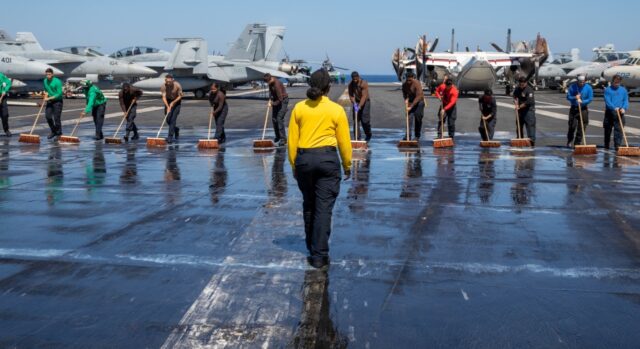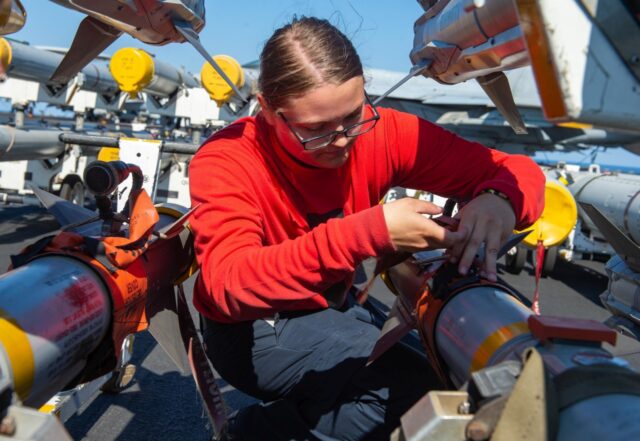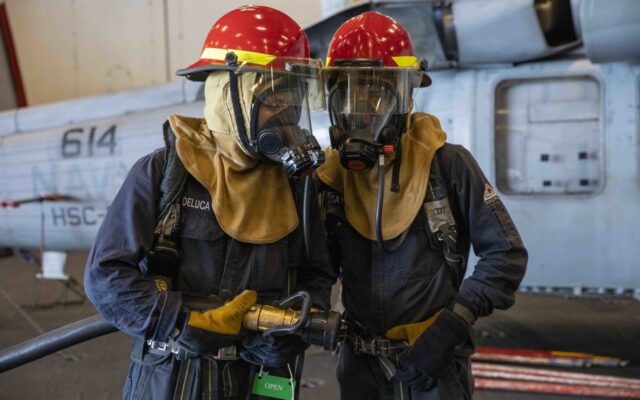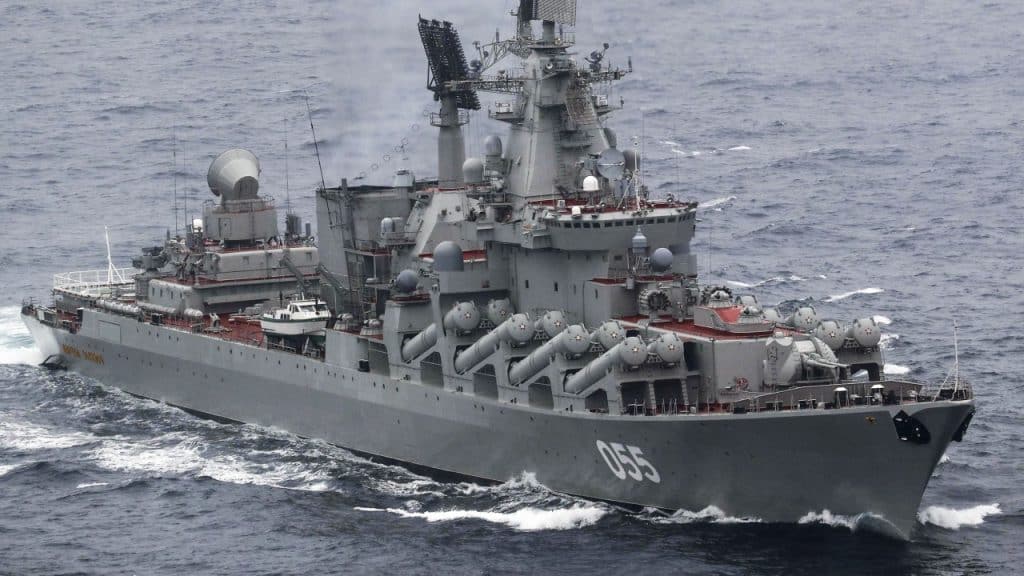The Russian cruiser Marshal Ustinov – so far in the waters of the Mediterranean Sea – crossed the Strait of Gibraltar yesterday and probably headed back to the home base in Severomorsk. Ustinov is one of the two remaining in service “far sea and ocean zone” missile cruisers of Project 1164 Atlant (NATO: Slava), the same one to which belonged Moscow, sunk in April.
According to USNI News, two hours after Ustinov’s departure for the Atlantic Ocean, two American destroyers from the USS Harry S. Truman (CVN 75) attack group – USS Cole (DDG 67) and USS Bainbridge (DDG 96) followed the cruiser. The Russians – apart from Ustinów, the tanker Wiaźma, which regularly accompanies him on long voyages, and the large ship ZOP, Vice-Admiral Kulakov of project 1155 Friegat, also followed the Spanish patrol plane P-3M Orion for some time.
Russian Navy Slava class cruiser RFS Marshal Ustinov Westbound Strait of Gibraltar this afternoon pic.twitter.com/Vx6N72OLsX
– Michael J Sanchez (@ key2med) August 24, 2022
-ADVERTISEMENT-

Ustinov arrived in the Mediterranean on February 7. During the same period, many other Russian ships entered the Mediterranean Sea, including the Varyag, the flagship of the Pacific Fleet, frigates and landing ships. Even then, there was no doubt that it was related to the crisis on the Ukrainian border and that if there was a war, the ships would either directly support the invasion or engage NATO’s reconnaissance (and combat) resources so that they could not be used to help Ukraine.
#Gibraltar
-Russian Navy Slava-Class Cruiser Marshall Ustinov.
-USS Bainbridge (DDG 96) Aleigh Burke-class guided-missile destroyer.
-Spanish Air Force P-3M Orion CISNE31. pic.twitter.com/ApesGzlEkx– Manu Gómez (@GDarkconrad) August 24, 2022
Project 1164 ships are armed with P-1000 Wułkan missiles with a range estimated at 700 kilometers. They are a development version of the previously used P-500 Basalt missiles, and their main purpose is to fight enemy aircraft carriers. In the case of Ustinov, on which the launchers were modified and their thermal resistance increased, the range of the Vulcans was allegedly increased to 1000 kilometers thanks to rocket accelerators. The cruisers also have relatively strong anti-aircraft weapons: eight blocks of eight S-300F Fort system launchers each with a maximum range of 75 kilometers using 5W55RM missiles. The launchers are located behind the chimneys and in front of the superstructure with the 3R41 Wołna radar.
In fact, there is no doubt as to the purpose of Ustinov’s and Varyag’s stay in the Mediterranean zone. Both cruisers, with their specialized missiles, were to be a counterweight to the American and possibly NATO carriers. In early February, NATO forces conducted exercises in which the American Truman, French Charles de Gaulle (R91) and Italian Cavour (C 550) took part along with their groups of support ships. At the end of March, due to the war in Ukraine, the American Secretary of Defense Lloyd Austin extended the operational trip of the Truman strike group.
@WarshipCam
US Navy in strait of Gibraltar eastnound
USS Farragut DDG 99
USS George HW Bush CVN 77
USS Truxtun DDG 103
USS Leyte Gulf CG 55
Aug 25 2022 pic.twitter.com/71t6TKfTQb– Peter Ferrary (@PeterFerrary) August 25, 2022
Cruisers versus aircraft carriers
Truman is still in the Mediterranean, but his nine-month voyage is slowly coming to an end as the Strait of Gibraltar passed yesterday – in the opposite direction to Ustinov – by the carrier USS George HW Bush (CVN 77). In early July, his strike team completed over a month of training exercises to prepare for this mission. For Truman, the past six months have been a period of strenuous work – his aviation component performed nearly ninety planes on some days.

Deck cleaning on the USS George HW Bush,
(US Navy / Mass Communication Specialist Seaman Curtis Burdick)
There are two separate points to the presence of Project 1164 cruisers. First, although they are formally “aircraft carrier killers,” in practice, if Russia were to clash with the US and the Atlants were ordered to attack Truman, it would be an order completely suicidal. As we wrote on the eve of the war, the only chance would be a coordinated surprise (in other words: first shots in the war) attack by a pair of cruisers using all available anti-ship missiles in the hope of breaking the defense with more effectors than with the potential of each individual effector. In such a situation, both cruisers would almost certainly end up on the bottom, but even one Vulcan, if they hit the right place, could take Truman out of action for a long time.
The aircraft carrier, however, does not operate alone and can rely on its escort alongside its own direct defense systems. In the case of Bush, it consists of the cruiser USS Leyte Gulf (CG 55) and the destroyers USS Nitze (DDG 94), USS Farragut (DDG 99), USS Truxtun (DDG 103) and USS Delbert D. Black (DDG 119). On top of that, the Americans had assembled a number of other destroyers on Mare Nostrum. Rather, the cruisers were a kind of fleet in being, which, although weaker, forces the opponent to protect themselves against it by its very existence.

Armorer on board Truman working with missiles.
(US Navy / Mass Communication Specialist 3rd Class Justin Woods)
On the other hand, one of our favorite analysts, HI Sutton, points out that Ustinov’s dismissal highlights the problems of the Russian Navy with prolonged operations away from their own bases. This stands in stark contrast to the Americans, for whom the Russian fleet is as ambitious as it is in terms of opportunities. The US Navy has an excellent logistic security network, combining its own components with the capabilities provided by allies.
And so American ships have been operating intensively in the Mediterranean Sea for six months. It is easy to guess that the Truman crew (as well as the crews of the accompanying ships) are exhausted, but endured as much as was necessary until the arrival of a substitute. In addition, the CVN 75 called at ports only for several-day visits. Meanwhile, Ustinov and other ships in the last quarter spent more and more time at the only Russian base in the region: Syria’s Tartus. A base that is not able to provide adequate service to such a large group of such large ships.

Sailors on the USS George HW Bush during a fire-fighting exercise.
(US Navy / Mass Communication Specialist Seaman Nicholas Avis)
Yes, one might say that the Naval Faction did not expect that it would be necessary to keep cruisers away from home bases for so long. But the Americans did not expect either. Truman was to spend several months in the Middle East, not six months in the Mediterranean. The US Navy has proved that it is able to make a rapid and long-term change of plans if necessary, when the strategic situation requires it, the Russian navy – that it is unable, or at least does not want to, and thus gives way.
Varyag will probably also call Tartus soon to prepare for the long voyage – back to Fokin near Vladivostok. Thus, Russia will not have a single “carrier killer” anywhere near the war zone, while the Americans – not without problems, but also successfully – will have at least one carrier strike group on hand, and temporarily even two.
See also: Wagnerists in Mali – bloody criminals, poor mercenaries
LPHOT Seeley, Royal Navy

